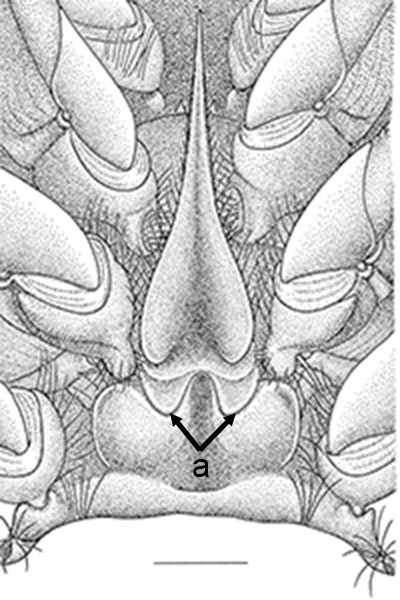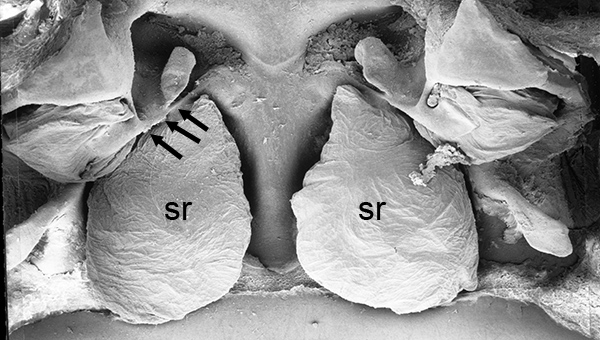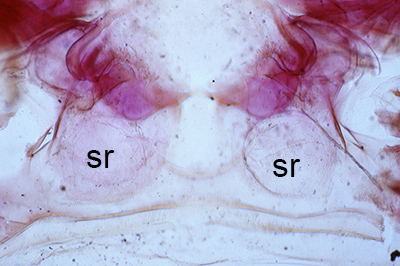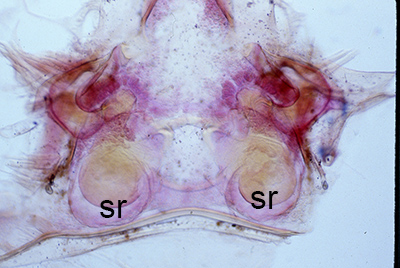



Another area of research in functional morphology has been on sexual appendages of both caridean and penaeoid shrimps. A knowledge of how sperm is transferred to the female and stored there until spawning is of interest both to applied and basic research. In shrimp aquaculture, an understanding of spermatophore transfer is useful in developing techniques of artificial insemination in selective breeding. In basic research on mating strategies, questions are asked such as: can more than one male inseminate a female, resulting in multiple paternity in a single spawning? Do males have adaptations to prevent insemination by other males (paternity assurance devices, such as mating plugs)
First, some information about sperm in decapod shrimps. As in all decapod crustaceans, sperm cells are immobile. The form of shrimp sperm is quite variable (see the excellent review by Braga et al. 2013)( Braga, A., C.L. Nakayama, L. Poersch and W. Wasielesky, Jr. 2013. Unistellate spermatozoa of decapods: comparative evaluation and evolution of the morphology. Zoomorphology 132: 61–284.) Sperm all have a small amount of cytoplasm, nucleus and acrosomal material. Sperm of many caridean species resemble a thumbtack, with a cap and a spike, but their are many variations. Penaeoid sperm usually have a somewhat globula cap and a spike, while stenopodidean sperm examined are rather flattened cells. Sperm produced by the testes are then packed in various materials to form spermatophores which males will deposit on the female during mating. Fertilization of eggs cells is always external in shrimps.
 |
 |
 |
 |
| Sperm cell of penaeoid Farfantepenaeus duorarum | Sperm cell of caridean Lysmata wurdemanni; mb, main body; s, spike (from Bauer and Holt, 1998) | Sperm cell of caridean Rhynchocinetes uritai (from Bauer and Thiel, 2011) | Sperm cell of caridean Thor manningi (from Bauer, 1986) |
Sperm are packed into spermatophores which are transferred by the male to the female's body during the mating. In carideans and stenopodideans, twin spermatophores formed in the testes and vasa deferentia (sperm ducts) are deposited on the underside of the female, usually between the last two pairs of walking legs on the female's posterior thorax. In at least one shrimp species (Heptacarpus sitchensis), they are deposited on the femailes first abdominal sternite. Spermatophores of carideans and stenopodideans are often simple, with many sperm packed into a gelatinous, sticky seminal material; in others, they may be somewhat more complex.
 |
 |
 |
Male gonads of caridean Macrobrachium rosenbergii. ed,, ejaculatory duct; gp, gonopores; mvd, median; pvd, mvd, dvd--proximal, median, distal vasa deferentia (in Bauer, 2023 from Chow, S., Y. Ogasawara, and Y. Taki. 1982. Male reproductive system and fertilization of the palaemonid shrimp Macrobrachium rosenbergii. Bull. Jpn. Soc. Sci. Fish. 48: 177-1982.) |
Ejaculatory duct of caridean Heptacarpus sitchensis.ag, androgenic gland; ejaculatory bulb; ed, ejaculatory duct, sm, circular muscle bands that contract during ejaculation to eject a spermatophore mass (from Bauer, 1976) | Stenopus hispidus male gonads. t, testis; vd; vas deferens. The male gonads of this stenopodidean species are quite small relative to those of carideans and penaeoid, sergestoid shrimps. (in Bauer, 2023 from Gregati, R.A., V. Fransozo, L.S. López-Greco, M.L. Negreiros-Fransozo, and R. Bauer (2014) Functional morphology of the reproductive system and sperm transfer in Stenopus hispidus (Crustacea: Decapoda: Stenopodidea), and their relation to the mating system. Invertebrate Biology 133(4): 381–393. |
 |
 |
 |
 |
| Twin spermatophores of Heptacarpus sitchensis, abundant sperm (sp) packed within a gelatinous adhesive seminal material (from Bauer, 1976) | Female H. sitchensis with twin spermatophores deposited on the underside of the first abdominal somite after a successful insemination by the male (from Bauer, 1976) | Twin spermatophores on the posterior thorax of a female Macrobrachium rosenbergii (from Bauer, 2023 after Chow et al. 1989) | Crossection through twin spermatophores of M. rosenbergii adhering to the underside of a female's thorax. am, adhesive material; pm, protective material, sm, sperm mass. (In Bauer 2023 from Chow et al., 1982) |
In caridean shrimp, small processes on the swimmerets
(pleopods) of males appear to be important in sperm transfer (Bauer, 1976).
Males of penaeoid species have very complex genitalia, called the petasma. Do these male processes and appendices serve in sperm transfer, stimulate females, species recognition of a mate, attachement to female during mating or some combination of the these? (See Bauer 2023 book: Chapter 6)
Males of almost all caridean species have a spinous structure of varying complexity, the appendix masculina (AM), on the inner branch (endopod) of the second pleopod (abdominal swimerette). Additionally, males of many species have coupling hooks (cincinnuli), often a stalk (appendix interna, AI) on the endopod of the first pleopod. Like the AI of the other pleopods, the AI hooks the endopods of pleopod 1 together so that they beat in synchrony.
 |
 |
 |
| Appendix masculina (am) on pleopod 2 of Heptacarpus sitchensis (from Bauer 2023 after Bauer 1976), a.i., appendix interna | am. and ai on endopod, pleopod 2 of Rhynchocinetes albatrosse (from Bauer, 2023 after Chace, 1997) | First pleopods of Heptacarpus sitchensis (left) and Atya innocous (right) showing appendix interna (ai). From Bauer (2023) after (a) Bauer (1976) and Hobbs and Hart (1982). bd, basipod; en, endopod, ex, exopod |
These male pleopods and their appendices are believed to be involved in sperm transfer in many caridean species, as shown with experiments with Heptacarpus sitchensis (Bauer, 1976) and Palaemon (Palaemonetes) pugio (Berg and Sandifer, 1984). A model of spermatophore transfer is shown below for H. sitchensis
 |
 |
| Mating sequence in H. sitchensis (1, male contacts female; 2, male grasps female, climbs on her dorsum; 3, male dips below the female; 4, male in copulatory and spermatophore transfer position (from Bauer, 1976) | Model of how male appendices transfer twin spermatophores to the underside of the female during copulation (A-E shows crossection through female first abdominal somite. am, appendix masculina; cx5, coxal segment of male pereopod 5 which bears the male gonopore; en1,2; endopods of male pleopods 1,2 (p1,p2); pp, pleural plate of female; st, female sternite (from Bauer, 1976) |
The spermatophores, male and female of gonads of penaeoid and sergestoid shrimps are quite diverse and usually often much more complex than those of carideans and stenopodideans. Complex spermatophores are produced by correspondingly complicated male gonads. In some species, substances are produced with which the male seals the aperture or apertures to female sperm storage structures ("seminal receptacles," "spermatheca")"
 |
 |
 |
 |
| Male gonads of penaeoid Rimapenaeus similis. Sperm produced by the testes moves through the seminiferous tubules into the proximal, median, and distal vasa deferentia into the sperm chamber of the ejaculatory duct with its gonopore. Sperm are molded in the vas deferentia into globular sperm packets which occupy the spermatophore chamber which opens to the gonopores. pvd, mvd, dvd: proximal, median, distal vas deferens; psc, plug substance chamber; sc, spermatophore chamber, seminferous tubule; t, testis (this and figures to the right from Bauer and Min, 1991) | During copulation ejaculation, sperm packets are inserted into a median chamber of the female thelycum (female genitalia) and then into the paired seminal receptacles inside the female thorax. The male then seals the apertures to the seminal receptacle chamber with the plug substance produced in the ejaculatory duct of the male. The plug substance quickly hardens and prevents other males from inseminating the female until her next mating molt. | External view of the female thelycum on the underside of her posterior thorax. The view above shows an uniseminated female with the apertures to the seminal receptacle chamber leading to the seminal receptacles. | Thelycum of an inseminated female with male plug substance protruding from the seminal receptacle chamber. This hardened material is a "paternity assurance device" which blocks other males from inseminating fhe female until her next molt, at which the cuticular thelycum, seminal receptacles and plug substance will be cast off and replaced with a clean set of genitalia readied for a new mating. |
Another example of a paternity assurance device in penaeoids is found In Farfantepenaeus (formerly Penaeus) duorarum, the commercially important of the Gulf of Mexico and southeastern coast of the U.S. During mating, the male inserts twin sperm masses into the female thelycum's median seminal receptacle which is covered externally by twin cuticular plates. A tighly rolled appendage attached to each of the sperm masses unfolds, covers the aperture to the seminal receptacle and hardens, preventing other males from inseminating the female until her next molt.
 |
| Sequence of the spermatphore reaction of Farfantepenaeus duorarum (see explanantion above). Far left, newly emitted spermatophore with "appendage" (ap) and sperm mass (sm). The sperm mass is inserted into the seminal receptacle. Upon exposure to seawater, the appendage unfolds and spreads out (middle, far right) to cover and seal the aperture to the seminal receptacle (from Cash and Bauer, 1991) |
Rimapenaeus and Farfantepenaeus are above are examples of penaeoids with "closed thelyca," i.e., species in which the female thelycum has apertures to a single median (Farfantepenaeus) or more often twin (Rimapenaeus) seminal receptacles. In such penaeoids, the male often seals the apertures to the receptacles with a male secretion. or plug. However, in the another closed thelycum group, the "rock shrimps, Sicyonia spp., the apertures are not sealed by the male. The male vasa deferentia do not form any type of plug substance and the spermatophores are simple cords of sperm inserted directing into the female's seminal receptacles. Mating experiments have shown that the lack of male mating plugs allows two or more males to mate with the same female and potentially deposit sperm in the spermathecae of a female (see Bauer, 1992b). The female may allow a male to copulate but not allow insemination. She may allow insemination of one receptacle but not the other, which may be filled by another male. Her offspring may have multiple fathers which has the advantage of genetic diversity of resulting offspring.
 |
 |
 |
 |
| Thelycum between the posterior female pereopods (walking legs) of Sicyonia edwardsii. Sicyonia spp. have closed thelyca (sperm stored in internalized seminal receptacles) but unlike most other closed thelyca penaeoids, the apertures (a) to the seminal receptacles are not covered by genital plates or other cuticular structures (from Perez Farfante, 1985) | Seminal receptacles (sr) of Sicyonia dorsalis, dorsal view from within the female thorax with other internal organs or structures removed. arrows point to where the apertures of the seminal receptacle open externally. | Cuticle of posterior thorax of a recently molted S. dorsalis female, cleared and stained for microscopy, showing empty seminal receptacles (sr). Any sperm that was within the receptacles before molting is cast off with the molt skin. The female will be receptive and attractive to males. (from Bauer, 1992b) | Seminal receptacles (sr) of a recently mated S. dorsalis female, showing filled receptacles. The brownish/yellowish material with the receptacles are sperm masses deposited by the male during mating. (from Bauer, 1992b) |
PUT IN HERE 4 IMAGE TABLE with Sicyoni diedswardii thelycum, SEM of S. dorsalis seminal receptacles; the S. dorsalis photos of empty, full receptacles
then introduce (all the above were closed thelyca, now open thelyca, with, without P-F Litopenaeus phore, then Metapenaeopsis photos with, without, sergestoid
Then male genitalia: litopenaeus setiferus or; three oddball ones, a trachypenaaeus, metapenaeopsis, macropetasmaideas about sperm transfer;
Make statement about stenopodidean gonads, genitalia (none), cite male gonads figure shown abov
Back to Home Page